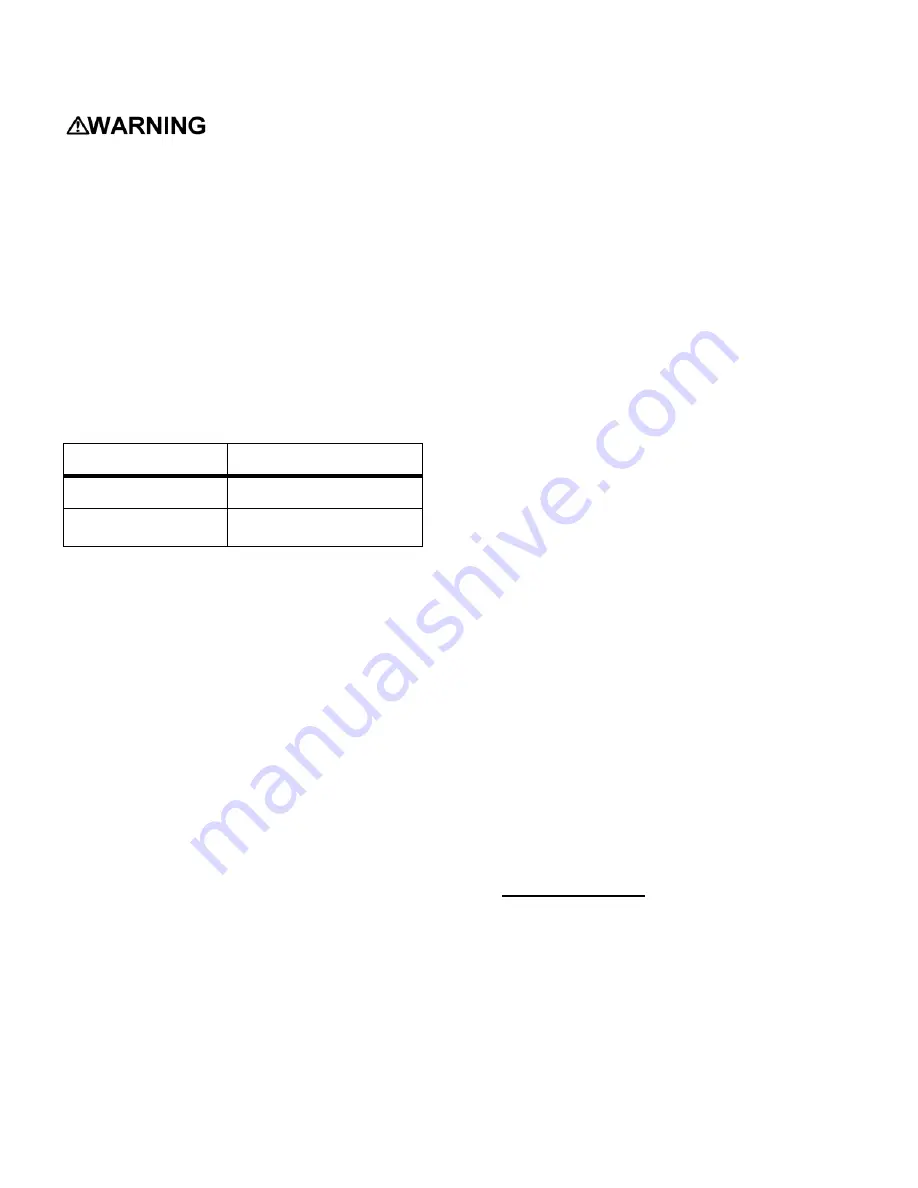
20
4.2
Replacing sensors
Removal or replacement of the
lithium battery or sensor in potentially combustible
atmospheres may compromise intrinsic safety. The
lithium battery or sensor used in the ToxiPro may
only be removed or replaced in an atmosphere that
is known to be non-hazardous.
The sensor in the ToxiPro may require periodic
replacement. To replace the sensor:
1.
Follow the directions in section 4.1 steps 1-3 to
remove the front housing.
2.
The sensor is located to the left of the LED alarm
light on the main board. Gently remove the old
sensor and install a new sensor of the same type.
3.
New sensors must be allowed to stabilize prior to
use according to the following schedule. The
detector must be powered off and functional
batteries must be installed for the sensors to
stabilize.
Instrument
Stabilization Period
ToxiPro O
2
1 hour
ToxiPro with toxic gas
sensor
15 minutes
4.
Once the sensor has stabilized, calibrate the
detector. For ToxiPro O
2
units, perform the Fresh
Air/Zero Calibration as described in section 3.3.
For ToxiPro units with toxic gas sensors, perform
both the Fresh Air/Zero calibration (section 3.3)
and the Span calibration (section 3.5).
Note: The ToxiPro must be calibrated after any
sensor change. See section 3.3 and 3.5 above for
details.
4.3
Proper Cleaning
The exterior surfaces of the ToxiPro may be cleaned
using a damp cloth only. Do not use cleaning agents of
any kind. The introduction of cleaning agents to the
detector may affect instrument functionality.
4.4
Storage
ToxiPro detectors may be stored for long periods in a
fresh air environment at temperatures between
10
C/50
F and 30
C/86
F.
5.
PC-Instrument
Communications
5.1
Event logging
Each ToxiPro includes a built-in event logger that stores
instrument readings during alarm conditions, calibration
values and other data. BioTrak software and an IrDA
port are necessary to download the collected data to a
PC. See section 5.3 for instructions on initiating
communications.
Warning, Danger, Custom, STEL and TWA alarms are
logged as events.
The event logger in ToxiPro version 9.20 or greater logs
will nest events. The
word “nested” in this case refers to
the logging of multiple events simultaneously. When the
instrument goes from Warning to Danger alarm condition
then both Warning and Danger alarms are being logged
as separate events.
Note: In ToxiPro versions less than 9.20 a single
event would be logged for a Danger event and
Custom alarms are not supported.
Even though latching is enabled, the event logger only
logs the actual time the instrument is in alarm condition
and not the duration for which the alarm was latched.
Since the Warning alarm level is less than/equal to the
Danger alarm level and the custom alarm level is greater
than/equal to the danger alarm level for all sensors
except oxygen, the sequence of these events usually is
Warning -> Danger -> Custom.
When the instrument goes into a warning alarm
condition the event logger starts recording data for the
warning event. When the instrument goes into danger
alarm condition, since the gas level is still greater than
the warning condition the event logger is logging data for
both warning and danger alarms. And when the
instrument goes into the custom alarm condition the
event logger is then logging data for 3 different event
types: - warning, danger and custom. When the gas
level goes drops below custom alarm level the custom
event would finish first, followed by the danger and then
warning.
For oxygen units the custom alarm value is always less
than the danger alarm. So the sequence of events would
be danger->custom. STEL and TWA events are not
valid for an oxygen instrument.
Eventlogger Capacity
The capacity of the event logger is 100 events. If the
capacity is exceeded, the memory will “wrap”. The word
“wrap” refers to deleting the oldest event and replace it
with the newest event. It is recommend to download the
instrument’s datalogger on a regular basis to prevent
data loss due to wrapping.





































